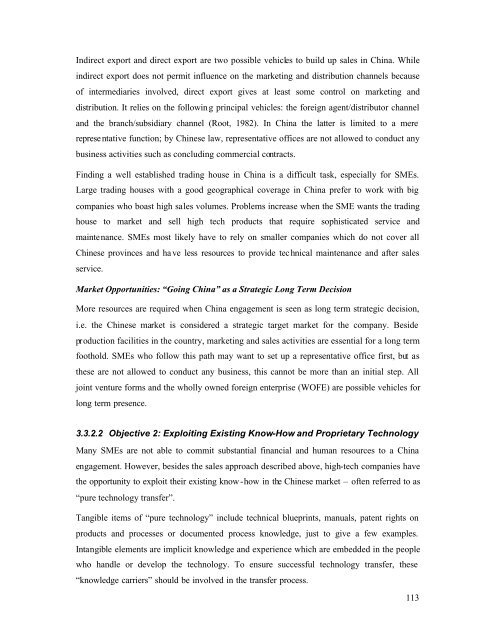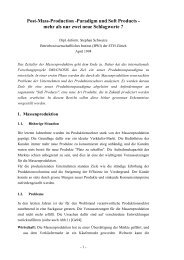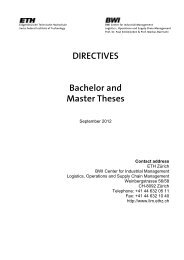The China Venture
The China Venture
The China Venture
You also want an ePaper? Increase the reach of your titles
YUMPU automatically turns print PDFs into web optimized ePapers that Google loves.
Indirect export and direct export are two possible vehicles to build up sales in <strong>China</strong>. While<br />
indirect export does not permit influence on the marketing and distribution channels because<br />
of intermediaries involved, direct export gives at least some control on marketing and<br />
distribution. It relies on the followin g principal vehicles: the foreign agent/distributor channel<br />
and the branch/subsidiary channel (Root, 1982). In <strong>China</strong> the latter is limited to a mere<br />
representative function; by Chinese law, representative offices are not allowed to conduct any<br />
business activities such as concluding commercial contracts.<br />
Finding a well established trading house in <strong>China</strong> is a difficult task, especially for SMEs.<br />
Large trading houses with a good geographical coverage in <strong>China</strong> prefer to work with big<br />
companies who boast high sales volumes. Problems increase when the SME wants the trading<br />
house to market and sell high tech products that require sophisticated service and<br />
maintenance. SMEs most likely have to rely on smaller companies which do not cover all<br />
Chinese provinces and ha ve less resources to provide technical maintenance and after sales<br />
service.<br />
Market Opportunities: “Going <strong>China</strong>” as a Strategic Long Term Decision<br />
More resources are required when <strong>China</strong> engagement is seen as long term strategic decision,<br />
i.e. the Chinese market is considered a strategic target market for the company. Beside<br />
pr oduction facilities in the country, marketing and sales activities are essential for a long term<br />
foothold. SMEs who follow this path may want to set up a representative office first, but as<br />
these are not allowed to conduct any business, this cannot be more than an initial step. All<br />
joint venture forms and the wholly owned foreign enterprise (WOFE) are possible vehicles for<br />
long term presence.<br />
3.3.2.2 Objective 2: Exploiting Existing Know-How and Proprietary Technology<br />
Many SMEs are not able to commit substantial financial and human resources to a <strong>China</strong><br />
engagement. However, besides the sales approach described above, high-tech companies have<br />
the opportunity to exploit their existing know -how in the Chinese market – often referred to as<br />
“pure technology transfer”.<br />
Tangible items of “pure technology” include technical blueprints, manuals, patent rights on<br />
products and processes or documented process knowledge, just to give a few examples.<br />
Intangible elements are implicit knowledge and experience which are embedded in the people<br />
who handle or develop the technology. To ensure successful technology transfer, these<br />
“knowledge carriers” should be involved in the transfer process.<br />
113






